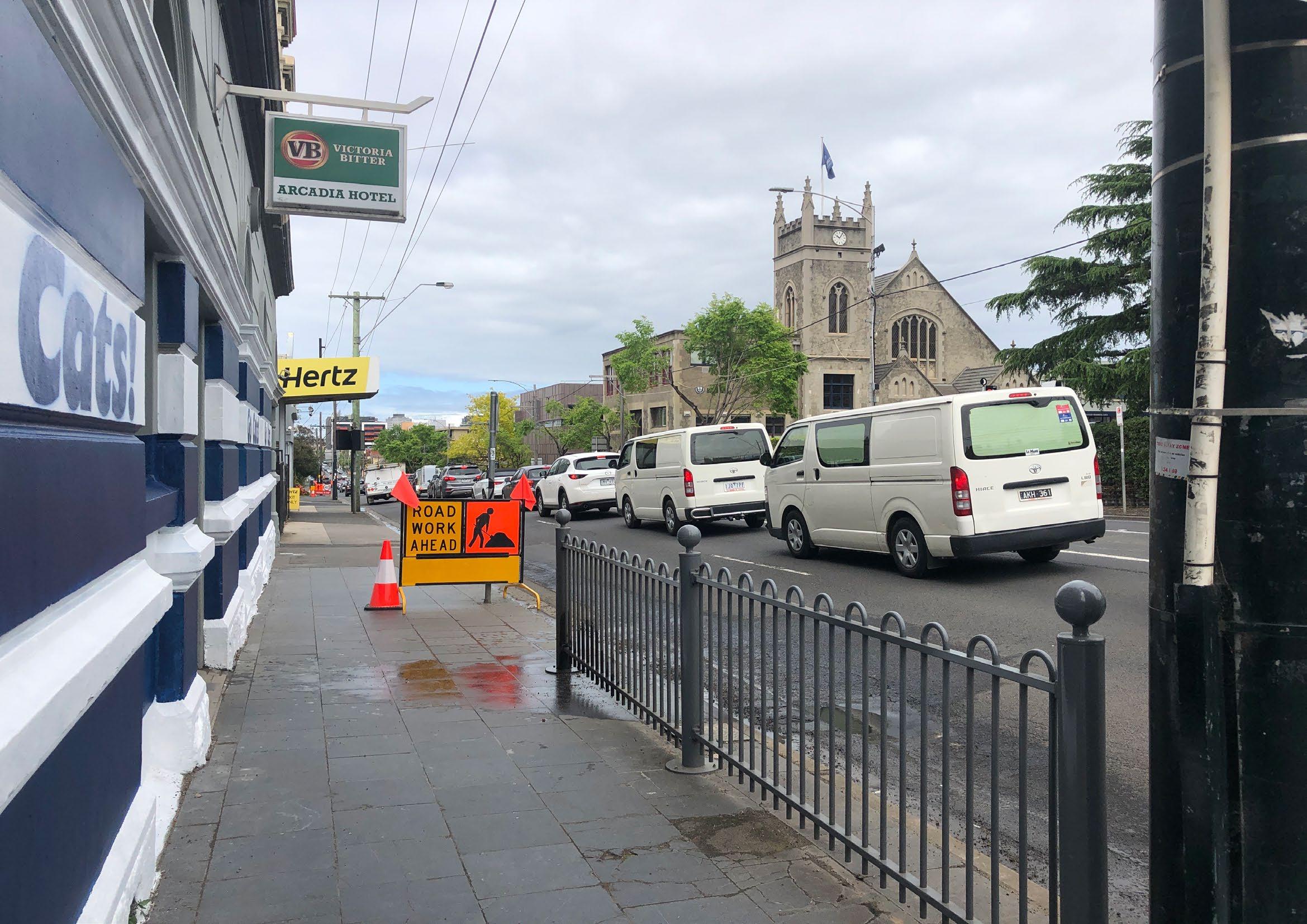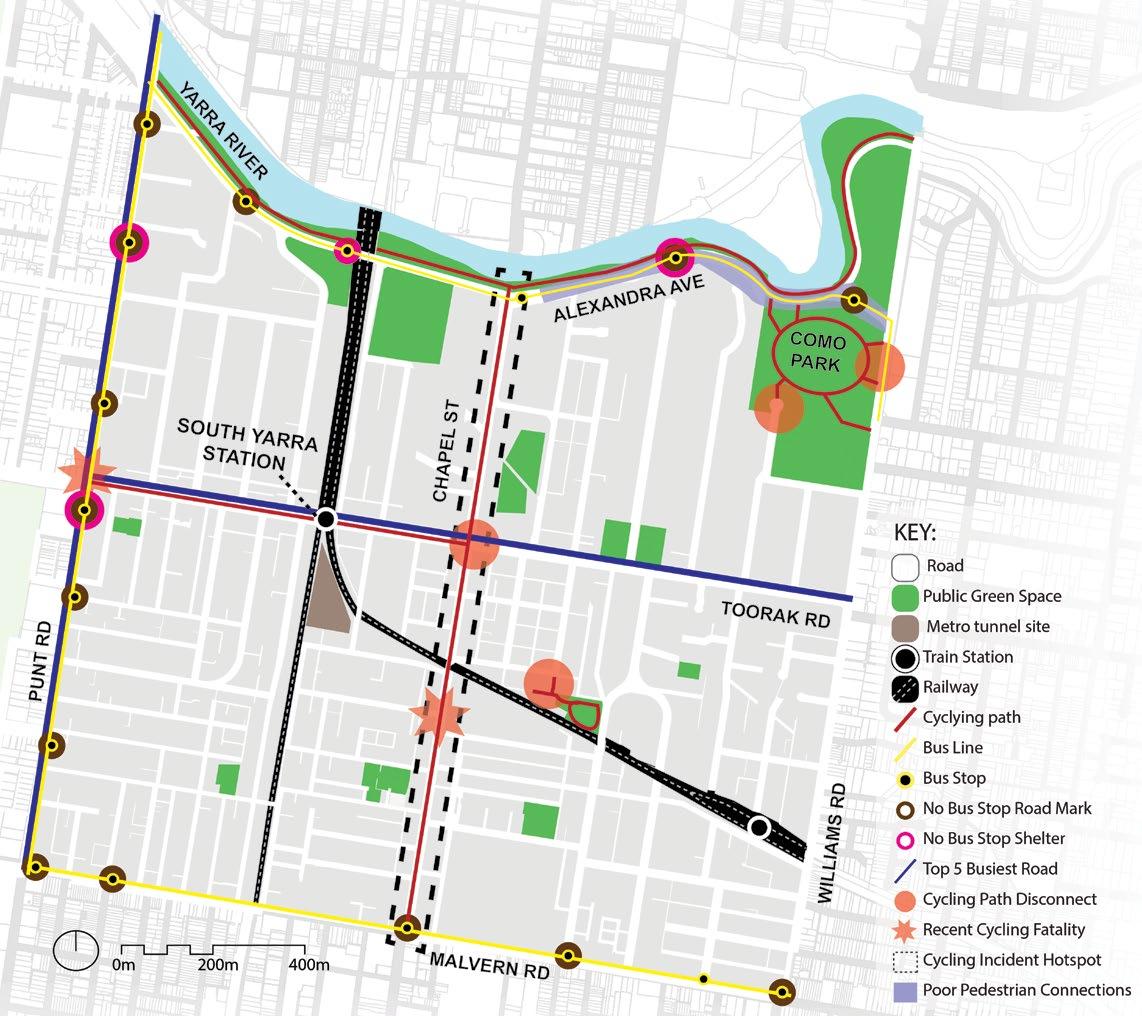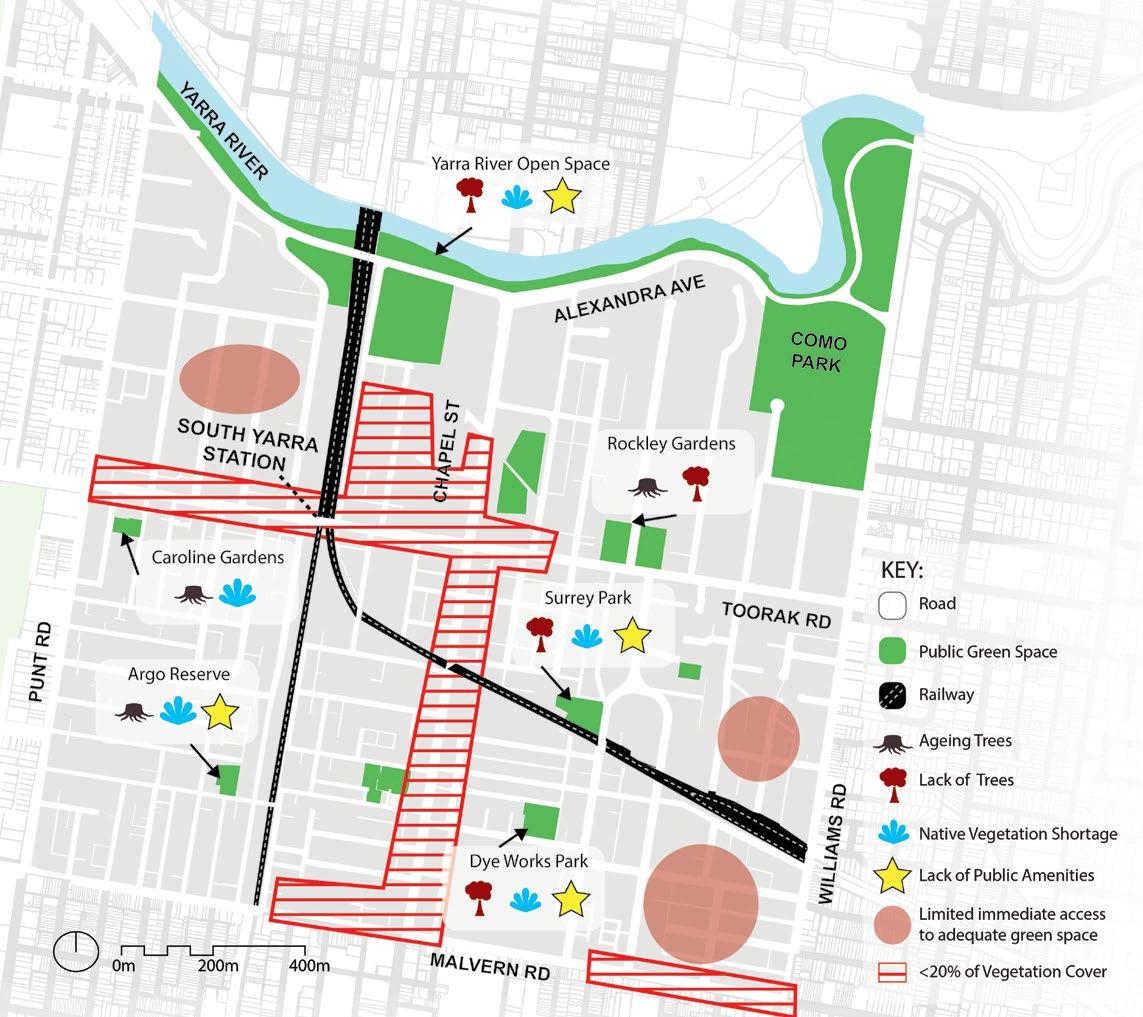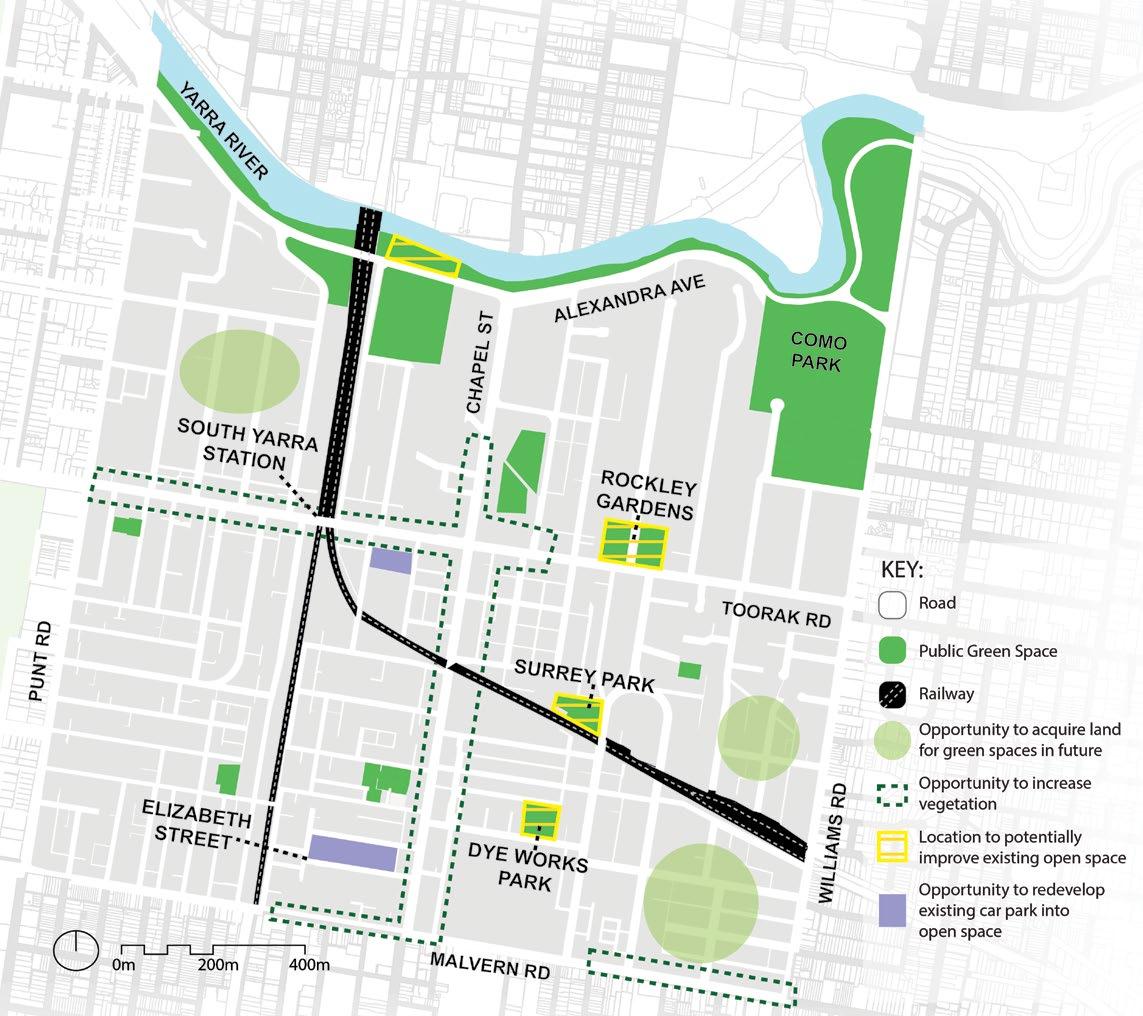
10 minute read
ISSUES AND OPPORTUNITIES
TRANSPORT & CONNECTIVITY
Issues 1.0
Advertisement
Issue 1.1: Safety problems for cyclists
The precinct’s lack of dedicated, safe cycling routes must be addressed, with many accidents occurring in the precinct (see Map 2.02). Additionally, disconnected paths make it difficult to cycle through, forcing cyclists to mix with cars, making the precinct a fearful location to bike in (Booker, 2020).
Issue 1.2: Precinct is built for private vehicle use
Servicing two of Melbourne’s five busiest roads, the precinct is heavily built for cars (Saunokonoko & Blancato, 2020). Given future threats of population growth and climate change, an increased number of cars is not sustainable in the precinct.
Issue 1.3: Inconvenient bus stops
The 246 bus along Punt Road and the 605 bus along Alexandra Avenue have poor amenities for its users, with little to no shelter or on-road signage, often with nowhere to appropriately cross to the other side of the road. This causes safety and comfort concerns, heightened given route 246 is one of the busiest in Melbourne (Cotter, 2019).
Other Transport & Connectivity Issues:
- Lack of pedestrian connectivity to green spaces - Traffic during peak hours - Narrow footpaths limiting foot traffic
Map 3.01: Transport and connectivity issues map (data: Google, 2020b; VicRoads, 2020).

Image 3.01: The bike lane along Chapel Street intersecting the parking lane unsafely. Image 3.02: Toorak Road, one of Melbourne’s busiest roads for private vehicles. Image 3.03: A bus stop for the route 605 along Alexandra Avenue.
TRANSPORT & CONNECTIVITY
Opportunities 1.0
Opportunity 1.1: Discourage private vehicle use
With the improvement of South Yarra Station confirmed, there is an opportunity to make more upgrades elsewhere to promote alternative modes of transport in the precinct (Jacks, 2018). Building on its already well-connected public transport (PT) system, the overall PT experience such as waiting for the bus or getting to the train station can be explored.
Working from Opportunity 1.1, connecting cycling to public transport can again encourage healthier modes of transport. Providing cyclists with a safe, fast and connected journey throughout the precinct can also help the economy, especially with potential COVID-19 distancing restrictions (Bicycle Network, 2020).
Opportunity 1.3: Revitalise bus services
Buses connect the precinct in areas where other forms of PT do not reach. The 605 bus especially is often a forgotten route, though there is great potential to increase its status and usage through various improvements, creating an enjoyable experience for users (Wong, 2019).
Other Transport & Connectivity Opportunities:
- Connecting pedestrians to green spaces - Dedicated walking trails
Map 3.02: Transport and connectivity opportunities map (data: VicRoads, 2020).

Image 3.04: Cars lining Rockley Road. Image 3.05: Cyclists riding through the Main Yarra Trail. Image 3.06: The 605 bus stopped along Alexandra Avenue.
HOUSING & LAND USE
Issues 2.0
Issue 2.1: Insufficient residential growth zones and little vacant land for new developments
As seen in Map 3.03, Residential Growth Zones are limited within the precinct. Vacant land, while populous in the commercial zones, is rare in residential areas (Schlesinger, 2020). Given forecasted population growth (see Figure 2.14), the precinct may face a lack of housing for future residents.
Issue 2.2: Poor transitional zones between commercial and residential areas
In the precinct, the divide between shopping and housing is blatant and abrupt, perhaps losing the sense of a precinct that is well-connected without barriers. The land is also underutilised, appearing dull for users (see Image 3.08).
Issue 2.3: High number of households experiencing rental stress
Within the precinct, 18.1% of households are experiencing rental stress, while 21.1% are paying around a third of their total household income on rent (ABS, 2016b). Rental stress has negative impacts beyond financial strain, with psychological problems also a common result (Robinson & Adams, 2008).
Other Housing & Land Use Issues:
- Car parks taking up valuable space - Housing in the precinct is unaffordable
Map 3.03: Housing and land use issues map (data: Atlas.id, 2020; Vic DELWP, 2020b).

Image 3.07: A house on Powell Street, off Toorak Road. Image 3.08: An awkward transitional space on Ralston Street near Toorak Road. Image 3.09: The car park on Elizabeth Street outside the Prahran Market.
HOUSING & LAND USE
Opportunities 2.0
Opportunity 2.1: Increase housing availability
Transitional zones have the potential to be redeveloped to provide more mixed land uses with the aim of providing more spaces for future residents. Similarly, residential growth zones can be reassessed to allow for further growth of residents.
Opportunity 2.2: Maximise underutilised spaces
Spaces such as car parks and quiet streets can be re-purposed to provide more opportunities for the local community to gather. It is important to consider, however, that the community has identified the importance of maintaining car parking within the precinct (City of Stonnington, 2015).
Opportunity 2.3: Combat climate change through housing
Recognising the current and future impacts of climate change, housing and construction of new resilient buildings that can withstand its effects should occur now (Reynolds, 2017). This has also been identified by locals, who have stated interest in future housing including ‘more environmentally sustainable design features’ (City of Stonnington, 2019).
Other Housing & Land Use Opportunities:
- Improve livability in public housing - Make housing in the precinct more affordable for all - Provide more diverse housing
Map 3.04: Housing and land use opportunities map (data: Vic DELWP, 2020b).

Image 3.10: The Ralston Street transitional space from an alternate view. Image 3.11: A small car park on Powell Street, taking up valuable space. Image 3.12: A mediumdensity complex on the corner of Toorak and Cromwell Rds.
PUBLIC SPACES
Issues 3.0
Issue 3.1: Lack of green spaces in low and medium density residential areas
A major issue within the precinct is the severe lack of green spaces, especially in residential areas (see Map 3.05). The local council have identified this, admitting the municipal is lacking adequate green space given its number of residents (City of Stonnington, 2013a).
Issue 3.2: Inadequate amount of facilities and amenities in both public areas and green spaces
A great city must include a range of well-serviced, frequent amenities (Garvin, 2016). Within the precinct, many streets and green spaces lack simple features such as drinking fountains and bins, creating an underwhelming environment (see Image 3.14).
Issue 3.3: Deficiencies of trees and healthy native vegetation
There are a high number of older trees compared to young trees in the precinct’s green spaces (City of Stonnington, 2017a). As the trees get old, their health will decline, resulting in their eventual loss. Similarly, areas are lacking in native vegetation and plantation, which provides character to public spaces (see Image 3.15).
Other Public Spaces Issues:
- Unattractive existing green spaces - Certain spaces not user-friendly
Map 3.05: Public spaces and natural environment issues map (data: City of Stonnington, 2017a; Google, 2020a).

Image 3.13: Rockley Gardens, an adequately-sized green area within the precinct. Image 3.14: An empty patch for trees on the corner of Osborne St and Toorak Rd. Image 3.15: Removal of old trees signage at Caroline Gardens, placed by council.
PUBLIC SPACES
Opportunities 3.0
Opportunity 3.1: Improve existing green spaces
Particular underutilised green areas can be improved to provide users with an enjoyable experience; becoming a destination for locals as opposed to simply an open, grassy area (see Image 3.16).
Opportunity 3.2: Create new green spaces
Residents have identified that parks and gardens are their most valued type of infrastructure, and accessing more of this now and in the future is of great importance (City of Stonnington, 2019).
Opportunity 3.3: Activate parks with better facilities
Servicing public spaces adequately is essential in improving their activity. Simple implementations such as drinking fountains provide health and environmental benefits in a convenient manner, while simultaneously encouraging people to drink water (Vic Health, 2016).
Other Public Spaces Opportunities:
- Provide more trees in public commercial zones - Design public spaces aimed at young adult age group

Map 3.06: Public spaces and natural environment opportunities map.
Image 3.16: Surrey Park, a rather empty green space in the precinct. Image 3.17: Elizabeth St near the car park, perhaps a location for a new open space. Image 3.18: The uninviting toilets found at Darling Gardens.
EMPLOYMENT & ACTIVITY
Issues & Opportunities 4.0
Issue 4.1: Safety problems
Generally more a problem for women and particularly in the evening, poor lighting plays a factor in compromised safety (see Image 3.19). Additionally, the active nightlife scene can often lead to alcohol-fuelled violence, as the local community has identified as concerning (City of Stonnington, 2015).
Issue 4.2: Businesses struggling
COVID-19 has hit the activity centre hard, with some businesses claiming in early September 2020 that they have not made any revenue since the first lockdown in March 2020 (Chapel Street Precinct, 2020).
Opportunity 4.1: Improve night environment
The usually busy nightlife could be further enhanced and made more prominent if all users (though especially women) felt safe at all times.
Opportunity 4.2: Support local
With COVID-19 restrictions likely to impact the site’s shopping precinct for many months to come, innovative COVID-safe ideas are essential to generate revenue once again.
- Inactive and unattractive commercial edges - Improve public amenities
Map 3.07: Business and employment issues and opportunities map (data: City of Stonnington, 2015).

Image 3.19: Contrasting light off Chapel Street (Chapel Street Precinct Association, 2020a) Image 3.20: One of many vacant commercial lots within the precinct.

Image 3.21: One of many ‘support local’ signs throughout the precinct.
SWOT ANALYSIS
A SWOT analysis provides valuable insight into any existing strengths and weaknesses within the precinct as well as any external threats and opportunities that will have an impact on the precinct going into the future.
S
STRENGTHS
W
WEAKNESSES TRANSPORT & CONNECTIVITY
- High level of access to public transport and connectivity overall in precinct
- High quality walking and cycling paths along Alexandra Ave
- Issues with safety on Punt Road and Malvern Road with bus and tram stops
- Issues with cycling safety and connectivity throughout the precinct
HOUSING & LAND USE
- Housing is close to public transportation and the commercial hub
- There are several public housing services available in the precinct
- Housing is becoming too unaffordable
- There is low housing diversity as most dwellings are small in size, limiting the types of households and thus residents
PUBLIC SPACES
- Good maintenance of vegetation and amenities in green spaces
- An abundance of biodiversity in the Yarra River and the walking trails providing a positive environment
- Limited amount of green spaces, insufficient for precinct’s population
- Some green spaces in South Yarra have a shortage of native vegetations
EMPLOYMENT & ACTIVITY
- Good selection of local businesses with good support from council and other associations
- Active nightlife scene
- Safety issues, particularly surrounding women at night time
- Poor distribution of public amenities within the precinct
O
OPPORTUNITIES
- Metro Tunnel development workers will provide for local businesses
- Approved upgrades to South Yarra station provide more access and potential for higher capacity - Population growth can bring new diversity and business to the area
- Rapid development and investment in the private sector - Council’s proactive maintenance program allows a high quality of monitoring of trees and native vegetation
- Council’s Urban Forest Strategy allows for a green, sustainable future precinct - Council’s agreement to redevelop the Jam Factory will likely increase revenue
- COVID-19 will require businesses to think more creatively and practice safety measures, improving quality for clients
T
THREATS
- Population growth will make it harder to provide efficient transport for all residents
- COVID-19 creates challenges with space & accessibility for safe transport - Increasing living expenses in the general area
- There is limited land zoned for new developments - Increase population growth will require better accessibility to green spaces
- Demand for lush greenery to mitigate heating up of the city in the face of climate change is increasing - Rising rates for already struggling local business owners
- COVID-19 strongly harming nightlife, with clubs and pubs forced to close indefinitely for long periods of time




